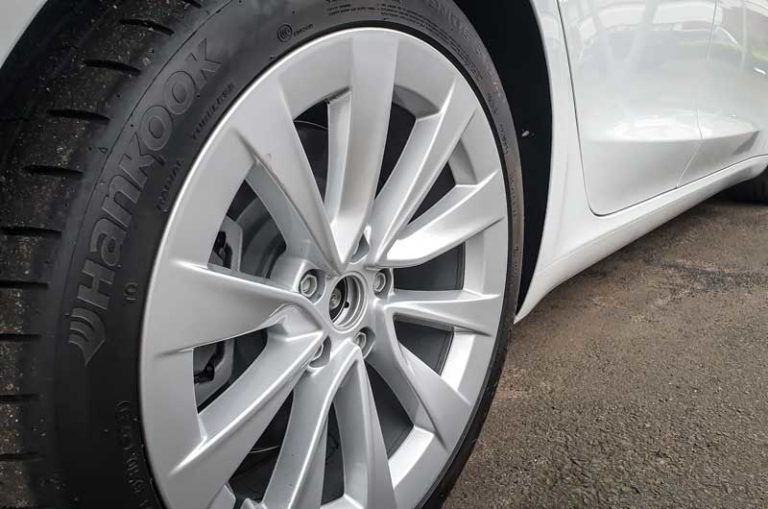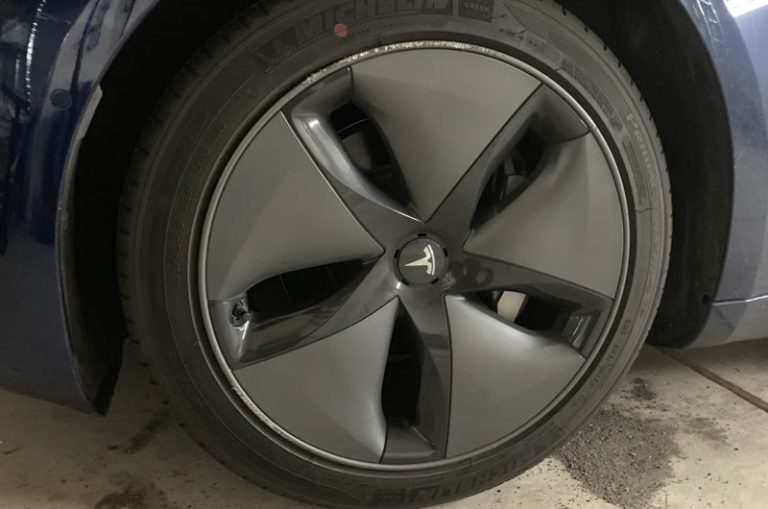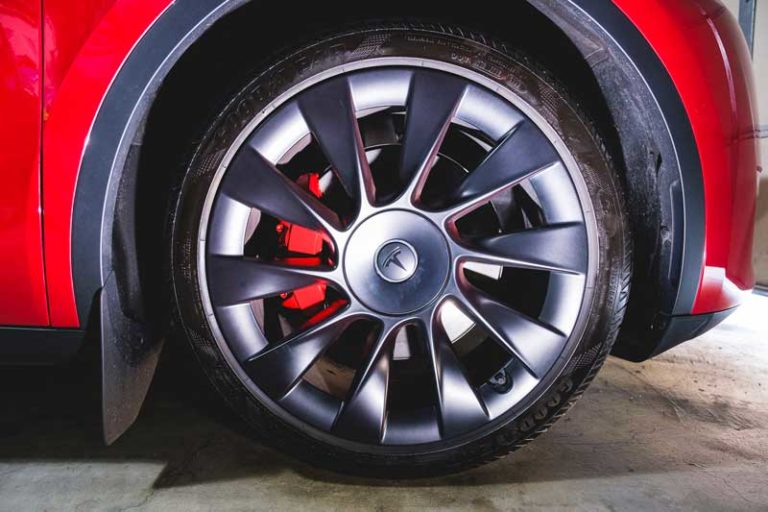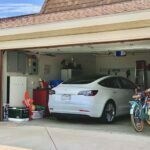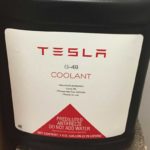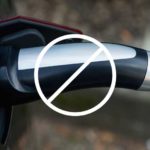The Tire Pressure Monitoring System on Teslas consists of pressure sensors inside the tires that relay information to your touchscreen. The system alerts you when the pressure in the wheel gets too high or too low.
Here’s how to reset Tesla tire pressure sensors in two ways:
- Use the touchscreen to reset the sensors.
- Drive above 40 km/h (25 mph) for at least 20 minutes.
The rest of this article will explain in more detail how to reset Tesla tire pressure sensors easily. I’ve also include additional information on how to take care of your Tesla tires.
- 1. Use the Touchscreen to Reset the Sensors
- 2. Drive above 25 mph for at Least 20 Minutes
- Can The Tire Pressure Sensor Resetting Fail?
- How To Check the Recommended Tire Pressure for Tesla
- How Should You Address Tesla Tire Faults?
- Frequently Asked Questions
- Why is Tesla Tire Pressure So High?
- How To Put Air In Tesla Tires (at Home Or Car Repair Shop)
1. Use the Touchscreen to Reset the Sensors
The touchscreen contains all the commands you can input in your Tesla, including tire pressure reset.
You can reset tire pressure sensors using the touchscreen as follows:
- Turn the ignition and press and hold the brake pedal.
- Tap the car icon to access the control menu.
- Select “Service” from the menu that appears on the screen.
- Select “Reset TPMS Sensor.”
- Select Factory Reset/Learn new pressures.
- Wait for 20 minutes.
- Drive at over 15 mph (24.14 kph) for at least 20 minutes.
Before starting this process, ensure that you’ve inflated the tires to the pressure Tesla recommends. You’ll find tire pressure information on the label placed on the door pillar.
Also, ensure that you’ve set the correct wheel size before resetting tire pressure sensors. Selecting the incorrect wheel size can trigger misleading tire pressure warnings.
Don’t attempt to remedy a tire pressure warning by resetting tire pressure sensors. You might be masking a real issue that requires your attention.
Scroll to Car Status to check whether the reset was successful. If there are no pressure figures displayed, the reset worked.
Tesla recommends that you wait 20 minutes before moving to the next step.
After completing the reset, you’ll need to drive the vehicle at over 15 mph (24.14 kph) for at least 20 minutes.
It’ll give the reset sensors a chance to learn the new pressures. The Tesla will display the pressure figures once it completes learning.
This YouTube video by YOUCANIC details the whole process:
2. Drive above 25 mph for at Least 20 Minutes
This system utilizes an auto-learning system introduced by Tesla in newer models.
After changing the tires, the TPMS sensors reset automatically after driving at over 40 km/h (25 mph). Drive at this speed for at least 20 minutes before checking whether the sensors display a figure.
Using this method, you don’t need to use the touchscreen with a newer Tesla model. Simply fit the right wheel at the correct pressure and drive.
How To Reset Tire Pressure Sensors in An Older And Newer Tesla Model
This table compares how to reset tire pressure sensors on newer and older Tesla Models.
| Tesla Model | How to reset tire pressure sensors |
| Older Tesla Models | Use the touchscreen to reset the TPMS sensors. Drive at over 15 mph (24.14 kph) for at least 20 minutes to complete the process. |
| Newer Tesla Models | Drive above 40 km/h (25 mph) for at least 20 minutes. |
Can The Tire Pressure Sensor Resetting Fail?
Resetting the tire pressure sensors is not difficult, but it can fail. If it fails, you’ll likely receive an error message informing you of that fact.
Tesla’s tire pressure sensor resetting can fail. It often happens because you have a faulty sensor, a poor wheel configuration, or the TPMS antenna isn’t working properly.
A failure to reset means there’s something wrong with your car that likely needs to be checked by an expert.
If the wheels were installed recently, start by checking the wheel configuration. If tire pressure sensor resetting continues to fail, check for a faulty sensor.
Also, ensure that you use tires that match the original specification. Failure to do so can lead to false tire pressure sensor failures.
If all sensors are okay, check the antennas of the TPMS (Tire Pressure Monitoring System).
On a related note, I also wrote a similar article about How To Display Tire Pressure on Tesla Model 3 and All Models. In this article, I went into detail about the specific topic including other common questions. Check it out!
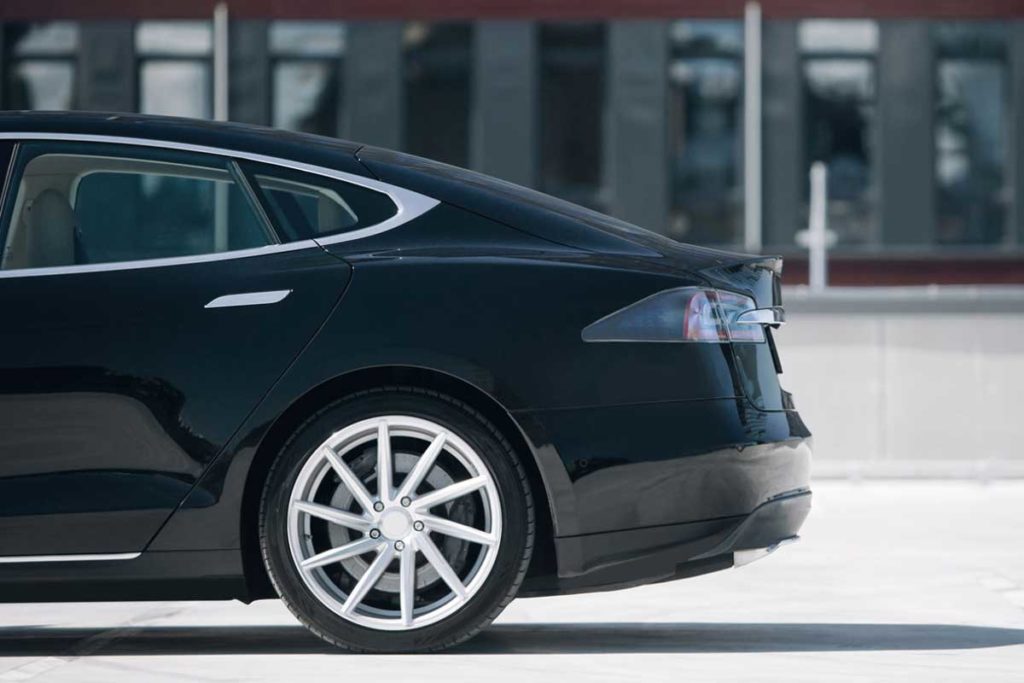
How To Check the Recommended Tire Pressure for Tesla
Electric vehicle tire pressure matters more than with ICE cars as incorrect tire pressures in EVs can drastically affect range. Therefore, you must inflate your Tesla tires to the recommended PSI.
You’ll find the correct tire pressure for Tesla on the center door pillar. Inflate to the pressure recommended by Tesla, even if it conflicts with the figure indicated on the tire.
The Tire Pressure indicator warning will inform you if one of the tires isn’t inflated to the proper pressure. Inflate or deflate the faulty tire to clear the alert.
Note that the warning won’t clear until you’ve driven at over 15 mph (24.14 kph) for more than ten minutes. Driving will activate the TPMS system, which will remove the warning light.
Outdoor temperature also has a massive effect on Tesla tire pressures. Tesla notes that a tire loses one PSI for every six-degree drop in temperature.
Therefore, Tesla recommends inflating the tires to the indicated pressure whenever it’s cold outside. Inflating the tire in hot temperatures increases the risk of under-inflation.
Under-inflation can cause many issues, including overheating, leading to increased tire degradation, which can cause an accident. It can also affect the vehicle’s range.
Over-Inflating Tesla Tires When Storing the Vehicle
Over-inflation is only recommended when parking the vehicle for long periods. Prolonged parking can lead to the development of flat spots, which cause vibration while driving.
To avoid the formation of flat spots, over-inflate the car to the maximum pressure indicated on the tire. Before driving, deflate to the tire pressure recommended by Tesla.
You can use this online Tesla tire calculator to find how long any Tesla Model tire will last. You can also estimate the number of miles left on your current set and how many days you have until they need to be swapped out for new ones. If that is the case, you can also find the price for any set of Tesla tires by selecting the appropriate tires. Have fun!
How Should You Address Tesla Tire Faults?
Tesla tire faults are remarkably similar to tire problems with any other car. If you’ve owned an internal combustion engine (ICE) car, you won’t have a difficult time managing faulty tires in your Tesla.
You can deal with Tesla tire faults by consulting your local tire shop. Tesla tires aren’t any different from ordinary tires, so your local tire expert won’t experience difficulty diagnosing whatever problem you have.
Perhaps the most common tire problem experienced by drivers is punctures. The tire sensor should alert you to a tire that’s deflating due to a puncture.
If the tire has enough air to make it to the tire shop, drive carefully to the shop before it deflates completely. If not, call for Tesla Roadside Assistance and wait.
On that note, I also wrote a related article Comparing Tesla Roadside Assistance with AAA. I found some interesting data. Check it out!
Remember that Teslas don’t come with spare wheels. Therefore, you can’t park on the side of the road to change the tire.
Once you get a flat, you need help. Note that Tesla Roadside Assistance is only available for the duration of your warranty.
After your warranty expires, you can call alternative roadside assistance or a flatbed to transport your car to the nearest tire shop or Tesla Service Center.
Ensure that the technician performs quality and permanent repair to seal the leak. Slow leaks can prove inconvenient, especially if you leave the vehicle for long.
Frequently Asked Questions
Here are a few questions Tesla drivers often ask about tire pressure:
Can I Replace a Faulty Tesla Tire Pressure Sensor at Home?
How Long Do Tesla Tire Pressure Sensors Last?
Tesla tire pressure sensors are available at reasonable prices. If you think that your car has a faulty sensor, your best bet is to replace it.
I recommend allowing the experts to replace faulty Tesla tire pressure sensors. It doesn’t cost much and will probably save you more time than attempting it at home.
Teslas are hardy cars that take care of their parts. Tesla parts are pretty durable, including tesla tire pressure sensors.
Why is Tesla Tire Pressure So High?
You might have noticed that Tesla recommends a higher tire pressure compared to some other vehicles. But fear not, there’s a method to this pressure madness.
Tesla’s tire pressure specifications are usually on the higher side for a couple of reasons.
First and foremost, maintaining higher tire pressure can contribute to better energy efficiency and range. By keeping the tires properly inflated, you reduce rolling resistance, which means less energy is required to move the vehicle forward. In simpler terms, it helps your Tesla glide smoothly and efficiently along the road, maximizing its electric potential.
Another factor to consider is safety. Tesla’s engineers have determined that a slightly higher tire-pressure can enhance stability and handling, especially during high-speed driving or sudden maneuvers. It’s like giving your Tesla a firmer grip on the road, allowing for better control and responsiveness.
However, it’s important to strike the right balance. While Tesla recommends a specific tire pressure, it’s crucial to check and adjust the pressure regularly to ensure it falls within the recommended range.
Extreme tire pressure, whether too high or too low, can lead to uneven wear, compromised handling, and reduced safety. So, grab that trusty tire pressure gauge (or use the built-in TPMS) and give your tires some TLC from time to time.
Now, it’s worth noting that tire pressure can also be influenced by external factors such as temperature. As the weather changes, tire pressure can fluctuate. In colder temperatures, the tire pressure may drop, while warmer weather can cause the pressure to increase. So, keep an eye on those pressure readings, especially during significant weather shifts.
How To Put Air In Tesla Tires (at Home Or Car Repair Shop)
Fortunately, adding air to your Tesla’s tires is a straightforward process. Here’s what you need to do:
- Locate the recommended tire pressure: Check your Tesla’s manual or the sticker inside the driver’s side door jamb for the recommended tire pressure. Tesla typically provides specific guidelines for front and rear tires, so make sure to note those numbers.
- Gather the necessary tools: To pump some air into your tires, you’ll need an air compressor or a visit to a gas station or car repair shop with an air pump. If you choose the gas station route, make sure to have some loose change or a credit card handy as some air pumps might require payment.
- Park your Tesla close to the air source: Position your Tesla near the air pump or compressor, ensuring that the hose can reach all four tires comfortably.
- Remove the valve cap: Unscrew the valve cap from the tire you’re starting with. Keep it somewhere safe so it doesn’t roll away and join a collection of lost socks.
- Attach the air hose: Take the nozzle of the air hose and firmly attach it to the valve stem. You might hear a slight hiss of air escaping, but that’s normal.
- Add air in short bursts: Begin adding air to the tire in short bursts, keeping an eye on the pressure gauge. You want to reach the recommended tire pressure but avoid overinflating. Check the pressure frequently using a tire pressure gauge to ensure you’re on the right track.
- Adjust the pressure as needed: If you find that the tire pressure is too low, continue adding air in small increments until you reach the desired pressure. On the other hand, if you accidentally go over the recommended pressure, simply press the small pin in the center of the valve stem with something like a key or a fingernail to release some air until you reach the correct level.
- Repeat for all tires: Move on to the remaining tires, following the same steps until all four of your Tesla’s shoes are properly inflated.
- Replace the valve caps: Once you’ve finished adding air to each tire, don’t forget to screw the valve caps back on securely. It’s a small but essential step to keep dirt and moisture out of the valve stem.
And there you have it! By following these steps, you’ll be a pro at putting air in your Tesla’s tires in no time.
Check out these 20 great gift ideas for yourself or a Tesla fanboy.
Contact Us if you have any questions or queries.


